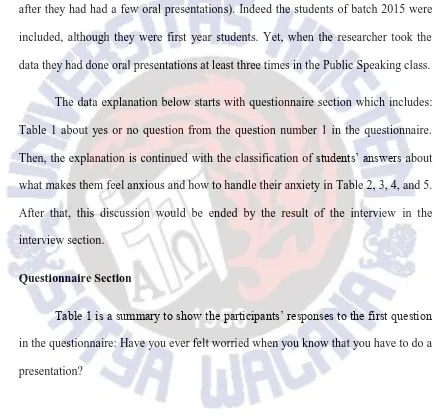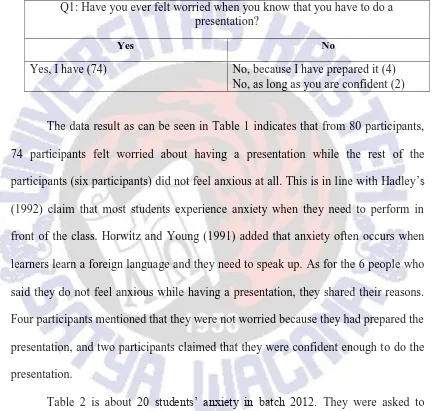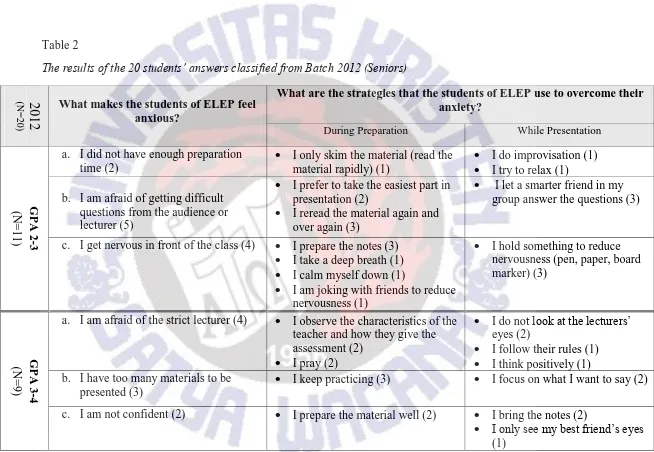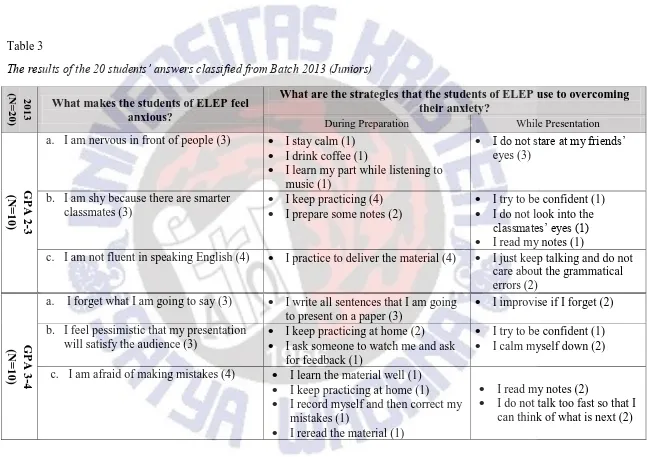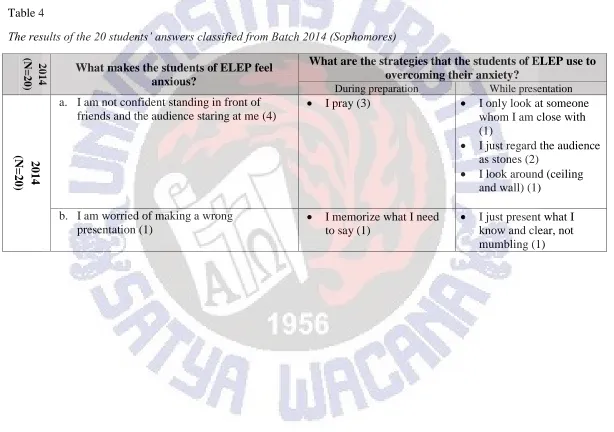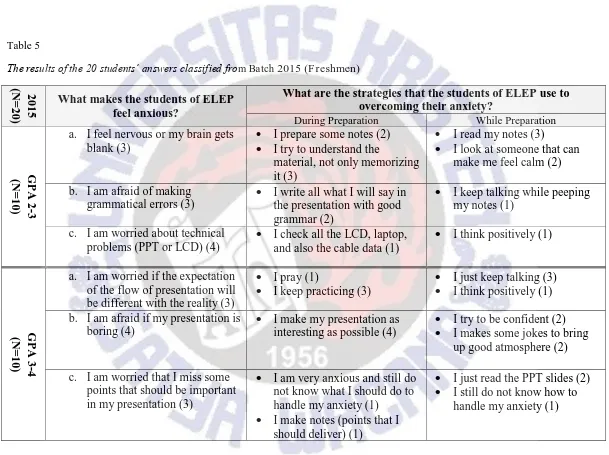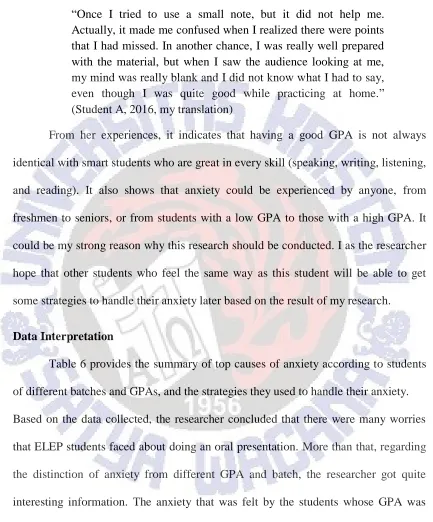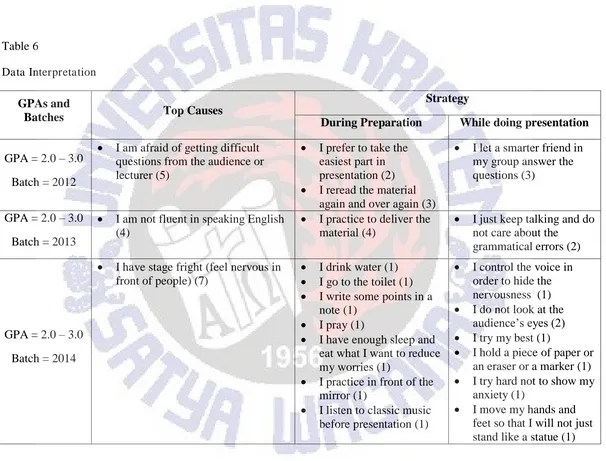STUDENTS’ STRATEGIES TO OVERCOME THEIR ANXIETY
IN ORAL PRESENTATION
THESIS
Submitted as a Partial Fulfillment of the Requirements for the Degree of
Sarjana Pendidikan
OEI STEFFI FERNANDA KURNIAWAN
112012060
ENGLISH LANGUAGE EDUCATION PROGRAM
FACULTY OF LANGUAGE AND ARTS UNIVERSITAS KRISTEN SATYA WACANA
SALATIGA
COPYRIGHT STATEMENT
This thesis contains no such material as has been submitted for examination in any course or accepted for fulfillment of any degree or diploma in any university. To the best of my knowledge and belief, this contains no material previously published or written by any others except due reference is made in the text.
Copyright @ 2016. Oei Steffi Fernanda Kurniawan and Gita Hastuti, M.A.
All right reserved. No part of this thesis may be reproduces by any means without the permission of at least one of the copyright owners or English Language Education Program, Faculty of Language and Arts, Universitas Kristen Satya Wacana, Salatiga.
TABLE OF CONTENT
COVER PAGE…………..………..………...i
PERNYATAAN TIDAK PLAGIAT………....ii
PERNYATAAN PERSETUJUAN AKSES……….……iii
Anxiety: Definition, Causes, Symptoms, and How to Overcome It…….…….4
INTRODUCTION
Learning a foreign language can be so exciting. However, it can also be so scary for those who are not brave enough to face the new challenges. The students who have that kind of anxiety will worry about and fear of many things. Horwitz, Horwitz and Cope (1986) argued that foreign language anxiety is a specific anxiety that some people experience when learning or using a foreign language. Woodrow (2006) also argued that anxiety is clearly an issue in language learning and has a demoralizing effect on speaking English for some students. In this statement, the students seem to be over-concerned about their ability to perform in the foreign language, which then causes them to feel anxious.
Considering the above problem, this should be resolved quickly because oral presentation takes a big part in the English language learning at the FLA. Almost in every course, there will be at least one individual or group presentation. Hence, the students are expected to find some ways to cope with the anxiety.
Based on the problem above, this research is aimed to answer these questions:
1. What makes English Language Education Program students feel anxious when they do a presentation?
2. What are English Language Education Program students‟ strategies to handle their anxiety?
The objective of the research is to find out what makes the students feel anxious and how they handle it. Possible varieties are examined from the participants‟ different batches and GPAs. This research expects to explore the differences and similarities in what makes the students feel anxious and the strategies used by different groups of students to cope with their anxiety.
LITERATURE REVIEW
Speaking and Oral Presentation
There are four skills that have to be learned in learning a language. Those are reading, writing, listening, and speaking. Yet this research focuses on speaking, especially the oral presentation because it is one of the skills that might cause anxiety the most.
Speaking. Penny (1996) believed that speaking skill is the most important
one since foreign language learners are most of all interested in becoming actual speakers of a language. Therefore speaking seems to be the most important skill that should be paid attention to in the process of teaching and learning. Through speaking courses, the students will be given opportunities to practice a new language.
According to Gert and Hans (2008, p. 207), “through speaking, people have an intention that needs to be understood by both the speaker and the audiences.” In addition, Brown (1994) and Burns & Joyce (1997) said that speaking was an interactive process of constructing meaning, which is comprised of producing and receiving information.
Oral presentation. In English speaking courses, the students are encouraged
presentation is like a formal conversation, speaking to a group as a natural activity.” Levin and Topping (2006) added that oral presentation is planned and practiced speech that is not memorized or read from notes but is introduced by a presenter to an audience. Furthermore, Hansen and Salemi (1998) claimed that an oral presentation can be structured as an individual presentation by each student or can be combined as case studies or group work with other students. In other words, those three experts believed that oral presentation is speaking to the audiences in order to deliver a piece of information or a report.
Anxiety: Definition, Causes, Symptoms, and How to Overcome It
Definition of anxiety. Brown (2000) and Ellis (2004) stated that learning a
foreign and a second language (FL/L2) involves various interrelated factors, and FL anxiety is one of the affective variables that play an important role in learning a new language. It seems that anxiety becomes a normal human feeling where people are worried about or afraid of something, which may influence the process of learning a language. According to Wiramihardja (2004), “anxiety is a feeling which is generalized from fear and worries. It is an alert that something like danger or a terrible experience will happen”.
of tension, apprehension, nervousness and worry associated with an arousal of the automatic nervous system. As a conclusion, anxiety is the feeling of fear and worries that can make people feel uncomfortable and uneasy of something that will occur.
What makes students feel anxious. If the students feel anxious, there must
be some causes behind it. Here the researcher gives 3 main points that can makes students feel anxious.
agreed that some students have fear when speaking in front of a group of people, moreover speaking in a foreign language.
Additionally, the result of the study done by Iizuka (2007) towards Japanese foreign students at a graduate school in America showed that many of them were anxious when speaking English with their peers and native speakers. The main reason for this was that they worried about being misunderstood and got stressed about making mistakes. They felt pressure about making language mistakes as well as presenting their opinions in front of their peers and teachers. Many of them felt uncomfortable about speaking in class and receiving questions they could not answer or not being able to explain themselves in English.
Lack of confidence. King (2002) stated that students were afraid of giving an
oral presentation because they had no experience in public speaking and some of them did not have confidence in their abilities. Additionally, Drew and Bingham (2001) argued that lack of confidence in presenting and talking to an audience could be attributed to a lack of familiarity with the content of the topic at hand. Therefore, lack of confidence really can make the students feel nervous and uneasy in speaking a language that they are not confident with.
themselves. In line with this, Penny Ur (2000), claimed that learners avoid trying to say things in a foreign language in the classroom, they were worried about making mistakes, fearful of criticism or losing face, or simply shy of the attention that their speech attracts. Hence, studies have shown that anxiety could give negative impacts to the students and it disables the real students‟ ability in giving a good performance. Yet, teachers‟ evaluation may also contribute. The way the teachers bring up the class, give feedback or correct students‟ mistakes may increase or decrease the students‟ anxiety.
Besides those three main points of causes that provided by the researcher, there were some additions from Elliot and Chong (2005) about the other causes that could come out from the anxiety when the students did an oral presentation. Elliot and Chong mentioned that the causes were the presentation itself (the content, equipment and dealing with questions), personal attributes (communication aspects e.g. stuttering, language, physical appearance, anxious disposition) and evaluation (self-evaluation, reactions of others and grades).
Symptoms of anxiety. The symptoms of anxiety can be seen during students‟
Likewise, a speech therapist Lanerfeldt (1992) also stated that irregular heartbeat, perspiration, stumbling and an inability to act are a few symptoms that block one‟s capacity to act and speak. Furthermore, Cubukcu (2007) also mentioned the symptoms of anxiety include negative expectations, worry about the performance, and distress about others‟ perceptions.
How to overcome anxiety. Tanveer (2007) argued that the most general idea
to reduce anxiety was to make the language classroom environment less formal and more pleasant, where students can make faults without looking or sounding unskilled. It is essential for teachers to be friendly and make some fun class activities rather than being strict and uncared with the students. Indeed teachers should be more aware of the existence of anxious students and show empathy to them (Liu, 2009).
As an example to overcome the anxiety for the students, Kondo (1997) did in his research about the tactics for coping with language anxiety. For his research, he organized „Five-Cluster Solution‟ including: Preparation, Relaxation, Positive Thinking, Peer Seeking, and Resignation. The first, preparation, attempts at controlling the impending threat by improving learning and applying some study strategies (e.g. studying hard, trying to obtain good summaries of lecture notes). These strategies would be expected to increase students‟ subjectively estimated
The third, positive thinking is characterized by its palliative function of suppressing problematic cognitive processes that underlie students‟ anxiety (e.g. imagining himself giving a great performance, trying to enjoy the tension). These strategies are intended to divert attention from the stressful situation to positive and pleasant cues, and bring relief to the anxious student. The forth, peer seeking is distinguished by students‟ willingness to look for other students who seem to have trouble
understanding the class and/or controlling their anxiety. For the anxious student, the realization that others are having the same problem may serve as a source of emotional regulation by social comparison. The fifth, resignation is characterized by students‟ reluctance to do anything to alleviate their language anxiety (e.g. giving up,
sleeping in class). Students reporting examples of resignation seem intent on minimizing the impact of anxiety by refusing to face the problem.
Relevant Studies
Another similar study researching about students‟ anxiety and how to handle their anxiety is from Prastiwi (2006) titled Factors Contributing Students‟ Anxiety in Interpersonal Speaking Class in Universitas Kristen Satya Wacana. The results of this paper indicated that the students still experienced anxiety problem in second/foreign language, especially in doing individual presentation. Furthermore, factors that lead to students‟ anxiety were being afraid of making mistakes, lack of preparation, limited vocabulary, grammatical errors, lack of self-confidence, and friends/classmates embarrassment. The strategy that helped them to reduce their anxiety is ensuring themselves that they can do it, and they have to get prepared well for the materials.
The Study
Method
Three questions investigated in the questionnaire were as follows:
1. Have you ever felt worried when you know that you have to do a presentation? 2. What made you feel worried?
3. What did you do to handle your worries so that you could present well? a. During the preparation
b. While doing presentation Context of the Study
Participants
This study was administered to the students of the English Language Education Program in Universitas Kristen Satya Wacana. The researcher chose about 80 students from 4 batches in this program (2012, 2013, 2014, and 2015). Hence, the researcher only took 20 participants in each batch. The reason why the researcher chose 80 students from different batches was because the researcher wanted to know any possible differences or any interesting answers about what makes students usually feel worried or anxious and how they handle it, based on the differences of their batches and GPA.
Data Collection Instrument
For this study, the researcher used an open-ended questionnaire to collect the data. The reason was because the researcher wanted to gain as much information as possible from their perception and experience about anxiety, and not pegged only on the answers agree and disagree.
In the questionnaire, the researcher posed three questions as follows:
1. Have you ever felt worried when you know that you have to do a presentation? 2. What made you feel worried?
3. What did you do to handle your worries so that you could present well? a. During the preparation
Above those questions, the researcher also asked them to write down their student number and their GPA. (See Appendices). After studying the questionnaire results, the researcher did only one spontaneous interview out of curiosity with the background knowledge of this student and the reason of her answer. Thus, there was not a formal interview with a list of questions. The interview was done just to get additional information that was interesting from her answer.
Data Collection Procedure
the rules how to fill it. At that time, the researcher gave a brief explanation about the purpose of the research and the instruction to complete the questionnaire. After all the questionnaire data were collected, the researcher analyzed the data. After finding the result, the researcher conducted an interview to a student. The interview was recorded using a smart phone so that no important information will be lost. The interview took 8 minutes.
Data Analysis Procedure
After all the data had been obtained, the researcher classified their problems and strategies in overcoming their anxiety based on their batches and GPA. The form of the classification was almost the same as what Kondo (1997) had done. Yet, this study was not that simple, because the students shared different answers about their anxiety.
FINDINGS AND DISCUSSION
The data presented in this section were the responses to the questionnaires obtained from 80 participants of different batches in English Language Education Program with regard to the students‟ anxiety and the strategies that they used to handle the anxiety in oral presentation. In the questionnaire, the researcher did not use the word “anxiety” or “anxious” to avoid confusion. When conducting the piloting, the participants seemed unfamiliar with this word; therefore, I chose to use the word worry which is the closest synonym to anxiety.
The number at the end of every students answer means the frequency of the same answers to the question. Actually there were 20 participants in each batch, but since it was an open-ended questionnaire, the participants could mention more than one answer according to their experiences.
The participants who had taken part in the data collection in this thesis were the students who had done some presentations before. That‟s why, their answers in this questionnaire could be said valid (those were based on their own experiences after they had had a few oral presentations). Indeed the students of batch 2015 were included, although they were first year students. Yet, when the researcher took the data they had done oral presentations at least three times in the Public Speaking class.
The data explanation below starts with questionnaire section which includes: Table 1 about yes or no question from the question number 1 in the questionnaire. Then, the explanation is continued with the classification of students‟ answers about what makes them feel anxious and how to handle their anxiety in Table 2, 3, 4, and 5. After that, this discussion would be ended by the result of the interview in the interview section.
Questionnaire Section
Table 1 is a summary to show the participants‟ responses to the first question
Table 1
A summary result of Question No.1
Q1: Have you ever felt worried when you know that you have to do a presentation?
Yes No
Yes, I have (74) No, because I have prepared it (4) No, as long as you are confident (2)
The data result as can be seen in Table 1 indicates that from 80 participants, 74 participants felt worried about having a presentation while the rest of the participants (six participants) did not feel anxious at all. This is in line with Hadley‟s (1992) claim that most students experience anxiety when they need to perform in front of the class. Horwitz and Young (1991) added that anxiety often occurs when learners learn a foreign language and they need to speak up. As for the 6 people who said they do not feel anxious while having a presentation, they shared their reasons. Four participants mentioned that they were not worried because they had prepared the presentation, and two participants claimed that they were confident enough to do the presentation.
Table 2
The results of the 20 students’ answers classified from Batch 2012 (Seniors)
2012
(N=
20) What makes the students of ELEP feel anxious?
What are the strategies that the students of ELEP use to overcome their anxiety?
a. I did not have enough preparation
time (2)
I only skim the material (read the material rapidly) (1)
I do improvisation (1) I try to relax (1) b. I am afraid of getting difficult
questions from the audience or lecturer (5)
I prefer to take the easiest part in presentation (2)
I reread the material again and over again (3)
I am joking with friends to reduce nervousness (1)
I hold something to reduce nervousness (pen, paper, board
Based on the perception of the students whose GPA was 2.0 – 3.0, there were five students were being afraid of getting difficult questions from the audience. This case was similar as the research Iizuka (2007) has done. There, Iizuka stated that Japanese students who studied in America also felt uncomfortable about receiving questions they could not answer or not being able to explain themselves in English language. According to him, the main reason for his participants‟ anxiety was that they were worried about being misunderstood and got stressed about making mistakes. Iizuka still added that these students felt pressure about making language mistakes as well as presenting their opinions in front of their peers and teachers.
As these five students in this study knew that they sometimes felt anxious about the questions which could be asked by the audience or lecturer, they would do these as the strategies that they usually used during the preparation: three of them reported that they would reread the material several times until they understood it so that they could answer the possible questions, and two of them preferred to take the easiest part in presentation. Meanwhile, during presentation, they would let the smarter friend in the group to answer the questions to avoid making mistakes.
preparation for the presentation, the things that students usually did to handle their anxiety were praying, and trying to observe the characteristics of the strict lecturer and how the lecturer gave the assessment of the presentation before the day of the presentation. As the presentation was going on, they would not look at the lecturer‟ eyes, think positively and would try to follow the rule that the lecturer has set in the class.
The data in Table 3 was the summary of the anxiety of 20 students of Batch 2013 (the junior students). They also were asked to answer the questions: “What made you feel worried?” and “What did you do to handle your worries so that you could present well during preparation and while doing an oral presentation?”
Table 3
The results of the 20 students’ answers classified from Batch 2013 (Juniors)
2
What makes the students of ELEP feel anxious?
What are the strategies that the students of ELEP use to overcoming their anxiety?
I learn my part while listening to music (1)
I do not stare at my friends‟ eyes (3)
b. I am shy because there are smarter
classmates (3) b. I feel pessimistic that my presentation
will satisfy the audience (3)
I keep practicing at home (2) I record myself and then correct my
mistakes (1)
I reread the material (1)
I read my notes (2)
Besides, from four students whose GPA was 3.0-4.0, they worried if they would make mistakes while presenting their presentation. This result is similar with the previous study that Chandran, Munohsamy, and Rahman (2009) did. These experts also believed in their study‟s result that among ITB students were insufficient preparation, fear of making mistakes, lack of confidence, fear of audience, insufficient knowledge, mental block and lack of confidence in language skill would possibly causes of anxiety). As the strategy, from the students‟ perspective in ELEP, reading their notes and not talking too fast so that they could think of what should they said next.
Table 4
The results of the 20 students’ answers classified from Batch 2014 (Sophomores)
2
What makes the students of ELEP feel anxious?
What are the strategies that the students of ELEP use to overcoming their anxiety?
a. I am not confident standing in front of
friends and the audience staring at me (4)
I pray (3) I only look at someone whom I am close with (1)
c. I have stage fright (feel nervous in front of
b. I do not really comprehend or understand the material for the presentation (2)
I ask my friend who
I read other materials for more knowledge of the
d. I am worried about the presentation time (ex: 30 minutes presentation – what should I say?) (1)
I use a timer (1)
I make some points about what I should present (1)
From the group of students whose GPA was 2.0-3.0, five students of 2014 said that they have stage fright as their anxiety. Stage fright was often interpreted with nervousness or fear before public speaking or performance. It becomes a common thing that the students usually have when they need to do oral presentation if front of people. Based on the result, during the preparation, some students have different ways to overcome their anxiety such as drank water, went to the toilet, made a note (points that should they deliver), practiced in front of the mirror, listened classic music, prayed, had enough sleep and eat what they want. Additionally, they tried their best to deliver the presentation, so when doing the presentation, they also tried to overcome their anxiety as much as they could. Here, the students controlled the voice to hide the nervousness, they did not look at the audience‟s eyes, tried hard not to show their anxiety, moved their hands and feet so that they would not just stand like a statue, and they held a piece of paper, an eraser or a marker. This finding is in line with Kenneth & Melvin„s (2008) claim (as cited in Hsu, Tsu-Chia, 2011) that many people would feel greater nervousness when they are on the stage and afraid of interacting with the audience.
students worry. King (2002) stated that students felt worried about and afraid of giving an oral presentation because some of them did not have confidence in mastering the material.
To handle the lack of confidence, the students prayed before the presentation in order to have a smooth presentation, and while doing the presentation, they just regarded the audience as stones, and they would look around (ceiling and wall) or look at someone whom they were close with.
Furthermore, most of the students with the GPA of 3.0-4.0 still experienced the anxiety of lacking preparation and lacking vocabularies which usually happened or experienced by the students whose GPA was below 3.0. This phenomenon was also found in a study from Prastiwi (2006), in which the students commonly felt afraid of making mistakes, lack preparation, had limited vocabulary, often did grammatical errors, lack self-confidence, and had fear of friends/classmates embarrassment in doing presentation. Then, in order to handle their lack, they used easy words (not advance words) and memorized what they should say helped them to reduce their anxiety.
Table 5
The results of the 20 students’ answers classified from Batch 2015 (Freshmen)
2015
(N
=
20) What makes the students of ELEP feel anxious?
What are the strategies that the students of ELEP use to overcoming their anxiety?
I keep talking while peeping my notes (1)
c. I am worried about technical problems (PPT or LCD) (4)
I check all the LCD, laptop, and also the cable data (1)
a. I am worried if the expectation of the flow of presentation will be different with the reality (3)
I pray (1)
I keep practicing (3)
I just keep talking (3) I think positively (1) b. I am afraid if my presentation is
Here, four students in Batch 2015 whose GPA was 2.0-3.0 still felt anxious
about the technical problem (LCD or PPT slides). The students‟ strategiesto cope
with their anxiety are similar to Kondo‟s (1997) „Five-Cluster Solution‟ about preparation and positive thinking. In preparation, it attempts at controlling the impending threat by improving learning and study strategies. These strategies would be expected to increase students‟ subjectively estimated mastery of the subject matter, and hence reduce the anxiety associated with the language class. In the students‟ case, they were prepared about the PPT slides properly, then they
also need to check all the LCD, Laptop, and the cable data before the presentation. For the students while they did the presentation, they would like to think positively that the presentation would go smoothly.
For the students with GPA 3.0-4.0, they were afraid if their presentation is boring. The strategy that the students in Batch 2015 used to cope their anxiety during the preparation was trying to make the presentation as interesting as possible. Moreover, during the presentation, the students said that they would try to be confident and make some jokes to bring up good mood. According to Kim (2014), putting some jokes or stories, inside the presentation was also a good option, because it could create a comfortable situation for the audiences
As an addition, in the last row of the table about anxiety in Batch 2015, there was a student who found herself feeling anxious every time she had to do
answer, the researcher continued to investigate further using interview to that one
student. The results of the interview will be below Table 5.
Interview Section
The interview was held on the 20th May 2016. The subject for the interview was a respondent in Semester 2 of 2015 academic year. Below was the session about a respondent from Batch 2015 who had the GPA 3.0-4.0 yet she still did not know how to overcome her anxiety. This interview was aimed to seek the deeper answer of this respondent about her reason why she wrote that kind of answer in the questionnaire.
In the interview, the researcher did not do any chitchat for the opening of the interview but the researcher directly asked two questions. For the first question about what makes her feel anxious when doing an oral presentation. Below was the real answer of the respondent in Indonesian. The English translation is provided afterwards.
“Actually, I have a high GPA because I am good at writing and reading courses. When the class comes with presentations, I have an anxious feeling even from the beginning of the semester, about how the presentation will be, how long it will be, with whom I will do the presentation, how if I get difficult questions, what I should wear, whether I will get a good mark in this lesson. That is why, with that much anxiety, I also feel upset how I should handle it.” (Student A, 2016, my translation)
The answer of Student A is in line with Elliot and Chong (2005) in determining the causes for presentation anxiety, which involves three main reasons: the presentations itself (the content, equipment and dealing with questions), personal attributes (communication aspects e.g. stuttering, language, physical appearance, anxious disposition) and evaluation (self-evaluation, reactions of others and grades).
Here, it appears that the anxiety of this student is much the same as the theory from Elliot and Chong (2005). On the other hand, she had tried many ways in order to overcome her anxiety, but she has not yet found the most suitable strategies. This condition was quite different from the other students who have already found their ways to handle their anxiety as explained in Table 2, 3, 4, and 5. Yet in this case, almost all of those strategies were not suitable for her.
“Once I tried to use a small note, but it did not help me. Actually, it made me confused when I realized there were points that I had missed. In another chance, I was really well prepared with the material, but when I saw the audience looking at me, my mind was really blank and I did not know what I had to say, even though I was quite good while practicing at home.” (Student A, 2016, my translation)
From her experiences, it indicates that having a good GPA is not always
identical with smart students who are great in every skill (speaking, writing, listening, and reading). It also shows that anxiety could be experienced by anyone, from freshmen to seniors, or from students with a low GPA to those with a high GPA. It could be my strong reason why this research should be conducted. I as the researcher hope that other students who feel the same way as this student will be able to get some strategies to handle their anxiety later based on the result of my research.
Data Interpretation
Table 6 provides the summary of top causes of anxiety according to students of different batches and GPAs, and the strategies they used to handle their anxiety. Based on the data collected, the researcher concluded that there were many worries that ELEP students faced about doing an oral presentation. More than that, regarding the distinction of anxiety from different GPA and batch, the researcher got quite
interesting information. The anxiety that was felt by the students whose GPA was
2.0-3.0 could be seen that the students still thought about their own concerns. Many
Some of the cases above is quite similar to the students from Chandran, Munohsamy,
Table 6
Data Interpretation
GPAs and
Batches Top Causes
Strategy
During Preparation While doing presentation
GPA = 2.0 – 3.0 Batch = 2012
I am afraid of getting difficult questions from the audience or
I am not fluent in speaking English (4)
I practice to deliver the material (4)
I have stage fright (feel nervous in front of people) (7)
GPA = 2.0 – 3.0 Batch = 2015
I am worried about technical problems (PPT or LCD) (4)
This is quite different from students who have GPA 3.0-4.0. Logically, the students having higher GPA, should have less anxiety than the ones with lower GPA,
but interestingly here, the students with higher GPA precisely experienced more
complex or more varied anxiety. Some of them are actually concern about the
opinions of others towards them. For example, they are worried to have a boring presentation or a poor performance, afraid of the strict lecturer, lack vocabularies, and afraid of making mistakes that could not satisfy the audience and lecturer.
For the strategies, the students have their own ways to handle their anxiety. Yet a few same strategies are used when experiencing the different anxiety. The first example is practice to deliver the material well during the preparation. This strategy is used by the students in Batch 2013 when they felt that they were not fluent in speaking English and they were afraid of making mistakes. In this case, practicing the material very well during preparation time could help them to overcome their anxiety. Similar to Kondo (1997) in „Five-Cluster Solution‟, preparation, it attempts at controlling the impending threat by improving learning and study strategies (e.g. studying and practicing hard). The second example when the students did the oral presentation, having positive thinking about the presentation could reduce their anxiety. This strategy was being used in Batch 2015 and Batch That was supported by Allan (2015), he argued that changing your mindset into the positive one was a good choice in dealing with the under pressure feeling. He also said that the way of presenter‟s thinking affected their performance in giving an oral presentation later.
CONCLUSION
This study was conducted to answer the research questions: “What makes ELEP students feel anxious when they do a presentation?” and “What are ELEP students‟ strategies to handle their anxiety?”
In this study, the researcher classified answers based on the differences in batch and students' GPA. Some of the students whose GPA was 2.0-3.0, still seemed concern about themselves. Many of them felt nervous and unconfident, their mind went blank, and they could not make eye contact with lecturers or classmates. Different with the students who had GPA 3.0-4.0, many of them were actually concerned about the opinions of others towards them. For examples: a boring presentation, poor performance, or unsatisfying to the lecturers.
By the presence of this study, the researcher hopes that the lecturer can realize
and be aware of the existence of anxious students so that they can help the students to reduce the students‟ anxiety problem. For examples: the lecturers can be friendlier to the students than to be lecturers who do not care about the children‟ problems and just focus on the assessment. Other than that, the lecturers can find fun class activities that would not make the students feel anxious in class and they could also give suggestions or motivation to the anxious students personally.
ACKNOWLEDGEMENTS
First of all I would like to thank Jesus Christ for all of His blessings to me. Without His help I am sure I cannot finish this thesis.
Second, I would like to express my deepest gratitude to Gita Hastuti, M.A. as my supervisor and Drs. Anton Wiguna, M.A. as my examiner for their time and patience in reading and correcting my thesis.
Third, I would also like to give many thanks to my beloved parents Harry Kurniawan and Lani Herawati, my only sister Jessica Marlinda and my brother-in-law Joko Hartono, my nephew Jason, and the last but not least Prajogianto family who kept praying for me from the beginning to the end of this thesis making process. Without their support, prayers, and fund, this thesis might not be finished.
Forth, I want to give my deepest gratitude to my friends in the group
“ILeHaYuNaRaLiBraChan” consisting of Bram Sivadjati, S. Pd, Natalia Devina, S.Pd, Happy Widesti, S.Pd, Maria Intan Permata, S.Pd, Kartika Dian Rahmadani, Yulietha Jubilate, Nanik Priyanti, Chanhyung Cho, and Sanghun Lee who helped me so much by giving me many suggestions, advices, and support during my study in UKSW until my graduation.
REFERENCES
Allan, P. (2015). How to calm your nervous before making a terrifying speech. Retrieved April, 15, 2016, from http://lifehacker.com/how-to-calm-your-nerves-before-making-a-terrifying-spee-1677504967
Andrade, K. E. (2008, Vol. 5, No. 2). Foreign Language Learning Anxiety in Japanese EFL University Classes: Causes, Coping, and Locus of Control. Electronic Journal of Foreign Language Teaching, 181-191.
Baker, A. (2000). Improve your Communication Skill. Kogan Page.
Beatty, M. J. (1988). Situational and predisposition correlates of public speaking anxiety. Communication Education, 37(1), 28-39. (From) http://dx.doi.org/ 10.1080/03634528809378701 Retrieved 21 October 2015
Bourne, P. E. (2007). Ten Simple Rules for Making Good Oral Presentations. PLoS
Computational Biology, 3(4), e77.
http://doi.org/10.1371/journal.pcbi.0030077
Brown, H. D. (2000). Principles of language learning and teaching (4th ed.). White Plains, NY: Pearson Education.
Brown, H.D. (1994). Teaching by principles: an interactive approach to languagePedagogy. Englewood Cliffs, NJ: Prentice Hall Regents.
Burns, A., & Joyce, H. (1997). Focus on speaking. Sydney: National Center for English Language Teaching and Research.
Chandran, S. K., Munohsamy, T., Rahman, H. M. (2006). Anxiety in orap presentation among ITB students. Retrieved September 30, 2015, from http://www.researchgate.net/publication/279197656_ANXIETY_IN_ORA L_PRESENTATIONS_AMONG_ITB_STUDENTS
Cubukcu, F. (2007). Foreign Language Anxiety. Iranian Journal of Language Studies, 1(2), 133-142.
Elliot, J. & Chong, J. L. Y. (2005). Presentation anxiety: A challenge for some students and a pit of despair for others. Retrieved on 10 April 2011 from http://www.isana.org.au/files/20051017165939_PresentationAnxiety.pdf. Ellis, R. (2004). Individual differences in second language learning. In A. Davies &
C. Elder (Eds.), The handbook of applied linguistics (pp. 525-551). Oxford: Blackwell.
Hansen, W. L. and M. K. Salemi, (1998), “Improving classroom discussion in economics courses in W. B. Walstad and P. Saunders, eds. Teaching undergraduates economics: A handbook for instructors, pp. 207-226, New York Irwin Mcgraw Hill
Horwitz, E. K., & Young, D. J. (Eds.). (1991). Language anxiety: From theory and research to classroom implications. Englewood, NJ: Prentice Hall.
Horwitz, E.K., Horwitz, M.B., and J. A. Cope (1986). Foreign language classroom anxiety. The Modern Language Journal 70, 125-132.
Hsu Tsu Chia. (2011). A study on the EFL students’ speech related anxiety in Taiwan.(From)
http://www.consortiacademia.org/index.php/ijrsll/article/view/74 Retrieved21 October 2015
Iizuka, K. (2007). A study of foreign language anxiety and anxiety coping: The case of English learning students in Japan. Unpublished master‟s thesis, Graduate School of Language, Communication, and Culture, Kwansei Gakuin University, Japan.
Khoury, P. (2015). A unique way to start a presentation and capture your audience’s
attention. Retrieved March 25, 2016, from
https://magneticspeaking.com/aunique-way-to-start-a-presentation-and-capture-your-audiences-attention/
King, J (2002). Preparing EFL Learner F or Oral P resentation. Dong Hina Journal of Humanistic Studies , 401-114.
Kondo, D. S.1997. „Strategies for coping with test anxiety‟. Anxiety, Stress, and Coping 10: 203–15.
Kurtus, R. (2001). Overcome the fear of speaking to groups. Retrieved October 20, 2015, from http://school-for-champions.com/speaking/fear.htm.
Lanerfeldt, M. Talängslan. A part of: Rudberg, L. (1992), (Red.), Barns tal-ochspråksvårigheter. Lund: Studentlitteratur.
Levin, P. and Topping, G. (2006). Perfect Presentations! Berkshire: Open University Press
Liu, M. (2009). Reticence and anxiety in oral English lessons. Bern: Peter Lang. Mitchell, O. (2009). How to prevent and recover from mind blanks. Retrieved March
29, 2016, from
http://www.speakingaboutpresenting.com/delivery/recovermind-blank/ North, M., & Rives, J. (2001). Virtual reality therapy in aid of public speaking.
International Journal of Virtual Reality 3:2-7.
Owens, M., Stevenson, J., Norgate, R., & Hadwin, J. A. (2008). Processing efficiency theory in children: Working memory as a mediator between trait anxiety and academic performance. Anxiety, Stress and Coping, 21(4), 417–430, doi: 10.1080/10615800701847823.
Prastiwi, N. A. (2012). Factors Contributing Students‟ Anxiety in Interpersonal Speaking Class. Retrieved Desember 8, 2015, from repository.uksw.edu/bitstream/.../740/2/T1_112007014_Full%20textt.pdf Rickheit, Gert and Strohner, Hans. 2008. Handbook of Communication Competence.
Spielberger, C. (1983). Manual for the state-trait anxiety inventory (STAI-Form Y). Palo Alto, CA: Consulting Psychologists Press
Tanveer M . 2007. „ Investigation of the factors that cause language anxiety for ESL/EFL learners in learning speaking skills and the influence it casts on communication in the target language‟. Unpublished Thesis, Faculty of Education, university of Glasgow.
Ur, P. (1996) A course in language teaching: practice and theory. Cambridge: Cambridge University Press.
Ur, Penny. 2000. A Course in Language Teaching. Cambridge University Press Watson, D., & Friend, R. (1969). Measurement of social-evaluative anxiety. Journal
of Consulting and Clinical Psychology, 33, 448-457.
Wiramihardja, S. A. (2004). Pengantar Psikologi Klinis. Bandung: PT. Refika Aditama.
APPENDICES
Questionnaire Form
Student Number : ...
Student Batch (angkatan) : ... Student GPA : ...
Student Contact (for asking deeper information) :
The researcher wants to ask your help to complete this form. This questionnaire is made in order to finish her thesis. This is open-ended questionnaire, so you can write as many as possible what is in your mind about your anxiety in oral presentation. It can be before oral presentation and during oral presentation. You can also answer this quessionnaire in Bahasa Indonesia. Please describe your answers concretely (be detailed) and honestly. Don‟t be worried in completing this questionnaire, because it will not affect your grade and your name or your number will not be published.
1. Have you ever felt worried when you know that you have to do a presentation?
2. What made you feel worried?
3. What did you do to handle your worries so that you could present well? a. During the preparation:
Thank you for completing this form and your answers will really help me. Best,
Oei Steffi (112012060)
Interview
A = The researcher B = The respondent
A : Hi, thank you for your time. As you know, here I want to interview you related to your answers in the questionnaire.
B : Alright, I understand, Kak.
A : Let‟s start the interview. Here, I think that your answers are quite interesting. You have quite high GPA, but you still feel anxious and do not know how to overcome it. May you explain it?
when I saw the audience looking at me, my mind was really blank and I did not know what I had to say, even though I was quite good while practicing at home.
A : Wow, thank you for your long explanation. Okay, so from what I get, first, you have felt anxious even from the early semester because that class have presentations, second, you have a lot of anxiety and have tried many ways but they do not help you at all. That is why you answered that you still do not know how to handle your anxiety.
B : I want to cope with my anxiety so that I can feel confident to talk in front of the class, I also want to be like my other classmates who are doing great in speaking. A : Actually I conduct this research because I have the same anxiety like you, I feel very nervous when I come forward to speak. Thus, it makes me eager to solve my own problem and also the problem of other students who have this kind of anxiety. I hope you will get some ways to handle your anxiety later based on the result of my research.
B : Wow, I will look forward to it, just contact me later when you have done your research.
